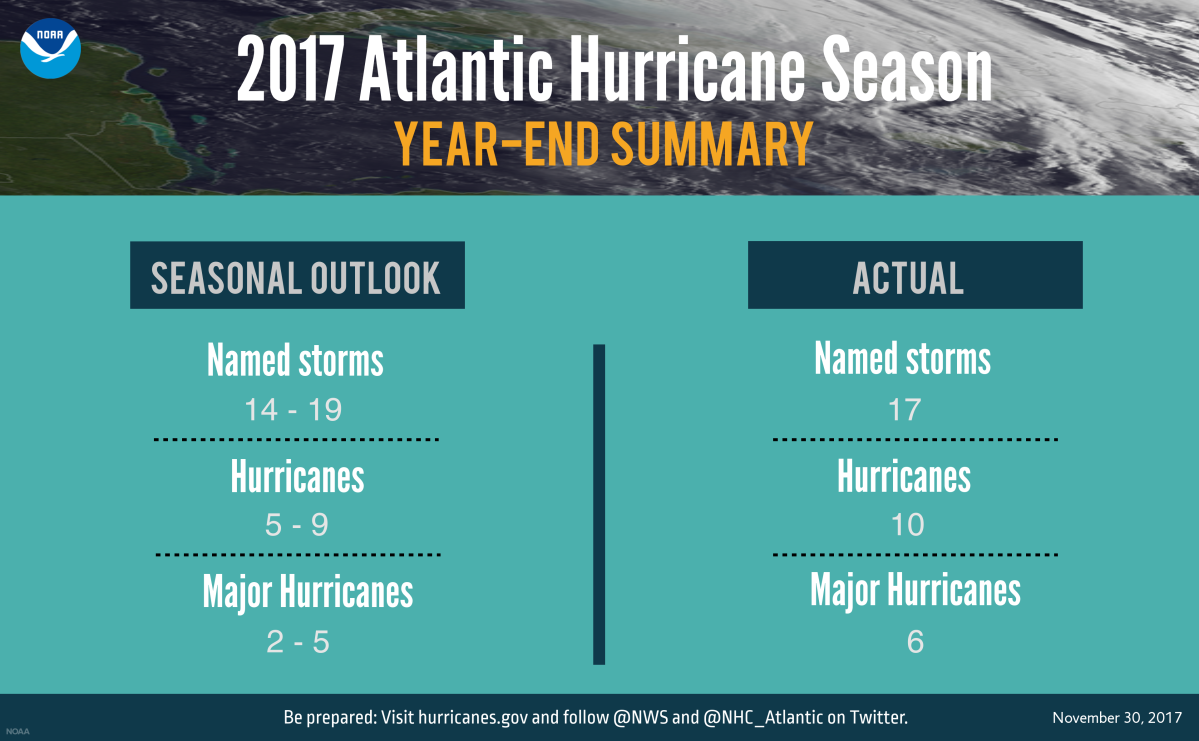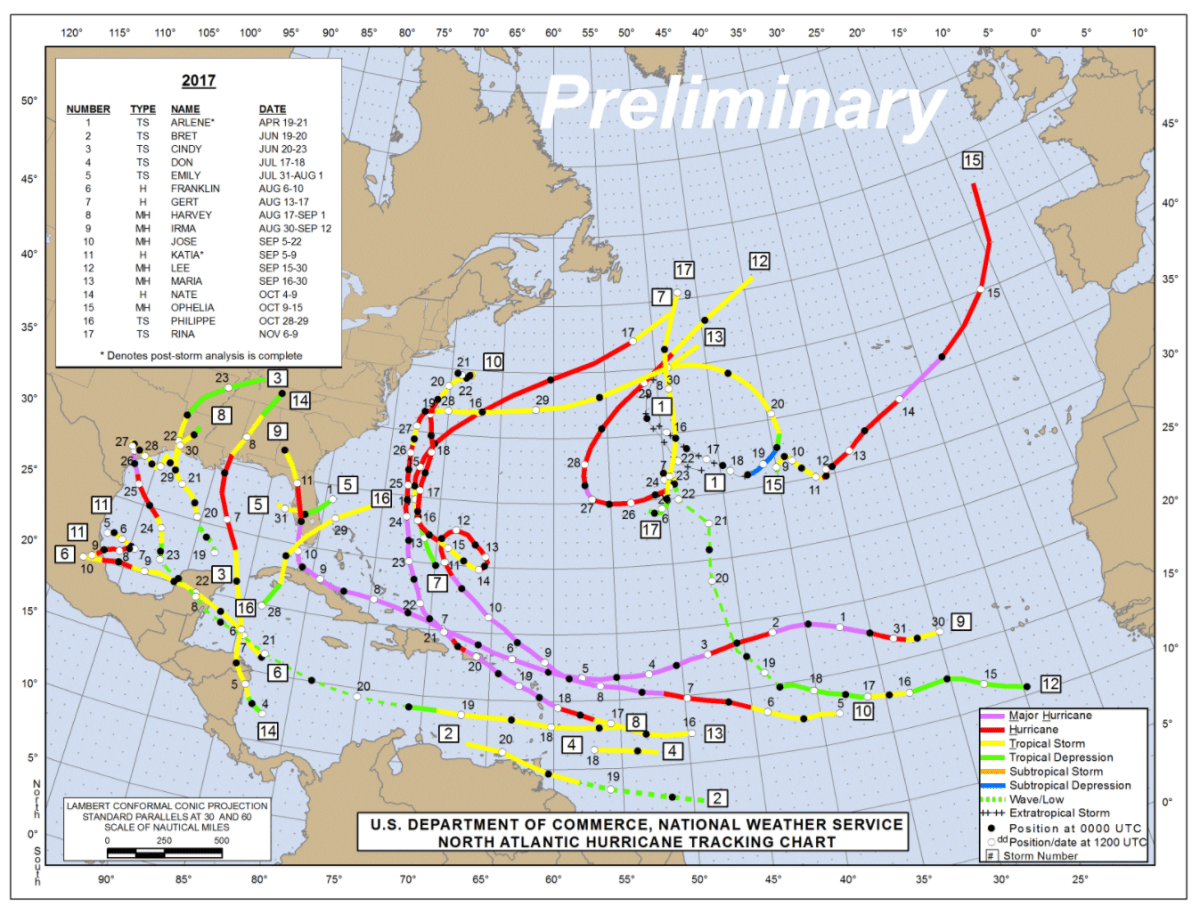This past year represented one of the deadliest and most destructive North Atlantic hurricane seasons in more than a decade, as a total of 10 hurricanes thrashed North America, the Caribbean, Central America, and parts of Western Europe.

The National Oceanic and Atmospheric Administration (NOAA) predicted an above-normal season, which held true.
An average season sees 12 storms named, six hurricanes form, with two of those evolving into major hurricanes.
READ MORE: Hurricane Maria leaves Puerto Rico in utter devastation
Even NOAA’s escalated forecast of five storms reaching the status of Category 3 or greater was smashed by Mother Nature, as she produced six major hurricanes, which contributed to making 2017 the costliest hurricane season on record.
Destruction from all 17 storms contributed to a total cost of nearly US$500 billion.
To put that in perspective, the six storms that struck the U.S. in 2005 caused $211 billion in damages.
2005 still remains the busiest Atlantic hurricane season, with 28 named storms, 15 of which were hurricanes.
This year proved that despite elevated storm activity, more than a century of research helped limit the number of people killed due to hurricanes.
WATCH: How strong do hurricane winds need to be to destroy a home?

Conservative estimates show about 300 people were killed by storms in 2017, which marks a massive decrease to the deadliest hurricane in U.S. history — the Galveston Hurricane in 1900 that claimed between 6,000 and 12,000 lives.
Hurricanes had such a presence this year, the word itself was a runner-up as Merriam-Webster’s word of the year.
HURRICANE HARVEY:
Aug. 17-30
Category 4
At least 82 killed
$180 billion in damages
Hurricanes Franklin and Gert represented the first two significant storms of the season when they churned up winds and waves in early August, but it was Hurricane Harvey that foreshadowed the devastation that was in-store for 2017.

Get daily National news
Harvey was the first Category 4 storm to hit the continental U.S. since 2004 when it struck the Texas coast near Corpus Christi on Aug. 25.
READ MORE: What Hurricane Harvey-level floods would look like in a Canadian city
Its 210 kph winds slowed dramatically the following day after it stalled over the mainland and was downgraded to a tropical storm — but the worst was yet to come.
The next three days saw record rainfall flood regions across southern Texas, only to have the storm move off the state before making landfall again over Louisiana on Aug. 30.
More than 102 trillion litres of water fell on the two states over a six-day period, equaling about a quarter of all the water in Lake Erie.
HURRICANE IRMA:
Aug. 30-Sept. 11
Category 5
At least 105 killed
$200 billion in damages
A week after Harvey left its trail of destruction, Irma roared across the Atlantic Ocean picking up steam and growing into a “potentially catastrophic” Category 5 storm as it threatened the Caribbean.
Between Sept. 6 and 9, the strongest hurricane ever recorded in the Atlantic basin, laid waste to the islands of Antigua, Barbuda, St. Martin, Anguilla, St. Kitts and Nevis, the U.S. Virgin Islands, British Virgin Islands, Dominican Republic, Turks and Caicos, Cuba and the Bahamas.
“A civilization that has existed in that island for close to, over 300 years has now been extinguished,” Ronald Sanders, the Antigua and Barbuda ambassador to the United States, told Public Radio International.
Hurricane force winds touching 200 kph destroyed nearly 95 per cent of buildings on the island of Barbuda, and was responsible for at least 44 people across the Caribbean.
READ MORE: Before and after satellite photos show devastated Caribbean islands
On Sept. 10, Irma slammed into the Florida Keys, as massive storm surges aided in the destruction of a quarter of the archipelago’s homes, before proving experts and models wrong when the weakened Category 3 storm tracked northeast, hitting Florida’s Gulf Coast.
A day later, Irma had weakened to a tropical depression, but still continued its wrath, knocking out power to thousands and causing widespread flooding to parts of Florida, Georgia and South Carolina.
Following Irma, a trio of hurricanes — Jose, Katia and Lee — formed in the Atlantic and the Gulf of Mexico bringing wind, rain and ocean swells with them.
Katia was the worst of the storms, despite only being a Category 1, as it was responsible for three deaths.
HURRICANE MARIA:
Sept. 16-26
Category 5
At least 66 killed
$95 billion in damages
But as those storms faded, Hurricane Maria strengthened and her Category 5 force threatened the same Caribbean islands that had beared the brunt of Irma just two weeks earlier.
On Sept. 18, Maria struck the island of Dominica, killing at least 27 people. It then flattened what was left on the British Virgin Islands following Irma’s fury.
READ MORE: Monster storm causes ‘mind boggling’ devastation in Dominica
Two days later, Maria became the strongest storm to strike the island of Puerto Rico in 85 years.
Maria crippled the island’s power grid, leaving some two million residents without power, representing the largest blackout in U.S. history.
The storm also incapacitated hospitals, ruptured a major dam, drained its fuel and water reserves, and sparked a war of words between the island’s leaders and President Donald Trump over federal emergency aid.
The island’s Department of Public Safety officially reported 64 people had been killed by the storm, but residents on the island claim the real death toll could be more than 500. The New York Times reported the number could exceed 1,000.
HURRICANE NATE:
Oct. 5-8
Category 1
At least 44 killed
$2.5 billion in damages
Hurricane Nate did its most damage as it moved through Central America in early October as a tropical depression.
Flooding and landslides triggered by the storm left at least 28 people dead across Costa Rica, Nicaragua and Honduras, before moving northeast into the Caribbean and developing into a hurricane.
READ MORE: The most striking photos from the aftermath of Hurricane Nate
Nate spared Cuba and the Yucatan peninsula, but made landfall near the mouth of the Mississippi River on Oct. 7.
Though not as powerful and destructive as its predecessors, Nate’s 145 kph winds knocked out power to 67,000 homes across the Gulf states, while heavy rain caused flooding up to 25 centimetres in areas.
HURRICANE OPHELIA:
Oct. 9-16
Category 3
At least 3 killed
$1.75 billion in damages
The final hurricane also claimed a record, travelling the furthest east of any other major North Atlantic hurricane.
Hurricane Ophelia grew to a Category 3 storm near the Azores islands, but weakened to a post-tropical storm as it tracked further north and made landfall in Ireland.
READ MORE: 3 people killed as Tropical storm Ophelia batters Ireland’s southern coast
Ophelia still remained dangerous, causing the deaths of three people and going on record as the strongest storm to ever hit Ireland.
The storm left a trail of downed power lines and trees, while a third of homes suffered some level of damage from Ophelia.














































































Comments